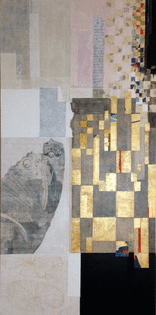
Upstate New York-based artist Jason Tennant carves powerful bird sculptures that dominate gallery walls in simulated flight. In his own words, "These works are a celebration of nature's resilience to human stresses and are my interpretation of the essence of wildness." Tennant's carvings are not as lifelike and representational as McCoy's, but are stylized evocative reminders of the strength of these taken-for-granted creatures.
These creatures are not taken for granted by a former college art mentor, Phyllis Kloda, who in 2009 creates a body of ceramics and paintings from a moment of awareness about birds. Actually, their absence. At her art opening at the Genesee Center for the Arts and Education gallery in Rochester, NY, Kloda speaks of a morning peculiarly quiet; a morning without the usual outdoor symphony of birds. What if suddenly there were no more birds? That morning is her muse.
On Saturday I watch a PBS news segment on the Audubon Mural Project currently underway in Manhattan. A collaboration of the Audubon Society and The Gitler & ___ Gallery, the selected subject birds are those that face extinction. Specifically, climate-threatened or endangered according to an Audubon report: 314 in total. While the project's genesis is a synchronous event for the society and artists, the project enlightening, and the meeting of art and science to highlight an environmental topic is inspiring, I am still aghast at the number 314.
This concept of no-longer-being is brought to light in McCoy's exhibit as well. The Carolina parakeet once populated my state of residence, South Carolina, in the not so distant past. According to the sculptor's website, "Already rare by the mid 1880s, its last stand was in Florida, where, in 1920, a flock of 30 birds was the last ever seen of the only native parrot of the United States." The demands of millinery couture for their colorful feathers was a dominant factor in the Carolina parakeet's demise. This historical fact renders me a bit queasy.
Recently I had a personal encounter with the bird kingdom, as I attempt to save a nestling in my backyard. A common response to my retelling of the story is, "Did the bird survive?" Wishing for a fairy-tale ending that I cannot honestly convey, I cite the natural selection process of an overcrowded nest. Two of the three nestlings fledged. The other I discover in the dirt not far from where I found the original - perhaps the very same bird that I rescued. But this encounter is beyond rescue. The nature of time claims the tiny bird's frailty, reducing it from feather and flesh to skeleton in a matter of weeks.
I am saddened by the plight that birds face due to humans' intrusive nature; in the same breath I am awed by the fierce beauty of birds and by the aesthetics of their artists. Which does not translate into the inclusion of these vertebrates in my own art. I am busy in the studio working with the iconic butterfly, with many of its species facing their own extinction. Perhaps by painting birds and collaging butterflies, we are all hoping for a fairy-tale ending.